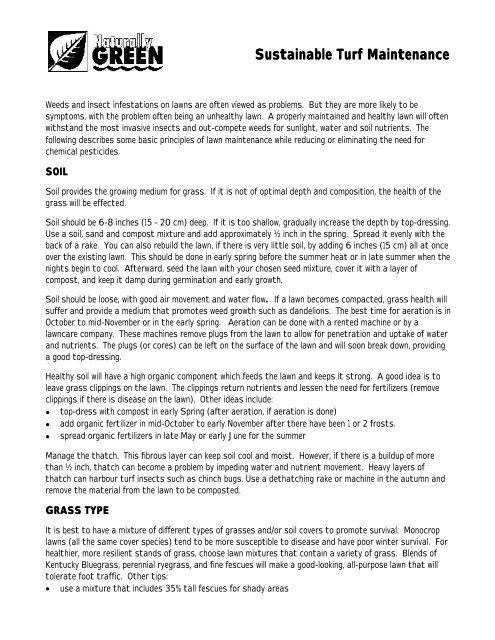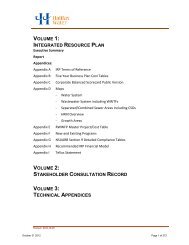Sustainable Turf Maintenance - Halifax Regional Municipality
Sustainable Turf Maintenance - Halifax Regional Municipality
Sustainable Turf Maintenance - Halifax Regional Municipality
Create successful ePaper yourself
Turn your PDF publications into a flip-book with our unique Google optimized e-Paper software.
<strong>Sustainable</strong> <strong>Turf</strong> <strong>Maintenance</strong><br />
Weeds and insect infestations on lawns are often viewed as problems. But they are more likely to be<br />
symptoms, with the problem often being an unhealthy lawn. A properly maintained and healthy lawn will often<br />
withstand the most invasive insects and out-compete weeds for sunlight, water and soil nutrients. The<br />
following describes some basic principles of lawn maintenance while reducing or eliminating the need for<br />
chemical pesticides.<br />
SOIL<br />
Soil provides the growing medium for grass. If it is not of optimal depth and composition, the health of the<br />
grass will be effected.<br />
Soil should be 6-8 inches (15 - 20 cm) deep. If it is too shallow, gradually increase the depth by top-dressing.<br />
Use a soil, sand and compost mixture and add approximately ½ inch in the spring. Spread it evenly with the<br />
back of a rake. You can also rebuild the lawn, if there is very little soil, by adding 6 inches (15 cm) all at once<br />
over the existing lawn. This should be done in early spring before the summer heat or in late summer when the<br />
nights begin to cool. Afterward, seed the lawn with your chosen seed mixture, cover it with a layer of<br />
compost, and keep it damp during germination and early growth.<br />
Soil should be loose, with good air movement and water flow. If a lawn becomes compacted, grass health will<br />
suffer and provide a medium that promotes weed growth such as dandelions. The best time for aeration is in<br />
October to mid-November or in the early spring. Aeration can be done with a rented machine or by a<br />
lawncare company. These machines remove plugs from the lawn to allow for penetration and uptake of water<br />
and nutrients. The plugs (or cores) can be left on the surface of the lawn and will soon break down, providing<br />
a good top-dressing.<br />
Healthy soil will have a high organic component which feeds the lawn and keeps it strong. A good idea is to<br />
leave grass clippings on the lawn. The clippings return nutrients and lessen the need for fertilizers (remove<br />
clippings if there is disease on the lawn). Other ideas include:<br />
• top-dress with compost in early Spring (after aeration, if aeration is done)<br />
• add organic fertilizer in mid-October to early November after there have been 1 or 2 frosts.<br />
• spread organic fertilizers in late May or early June for the summer<br />
Manage the thatch. This fibrous layer can keep soil cool and moist. However, if there is a buildup of more<br />
than ½ inch, thatch can become a problem by impeding water and nutrient movement. Heavy layers of<br />
thatch can harbour turf insects such as chinch bugs. Use a dethatching rake or machine in the autumn and<br />
remove the material from the lawn to be composted.<br />
GRASS TYPE<br />
It is best to have a mixture of different types of grasses and/or soil covers to promote survival. Monocrop<br />
lawns (all the same cover species) tend to be more susceptible to disease and have poor winter survival. For<br />
healthier, more resilient stands of grass, choose lawn mixtures that contain a variety of grass. Blends of<br />
Kentucky Bluegrass, perennial ryegrass, and fine fescues will make a good-looking, all-purpose lawn that will<br />
tolerate foot traffic. Other tips:<br />
• use a mixture that includes 35% tall fescues for shady areas
• seed mixtures with a higher component of perennial reygrass is better for rough terrains and informal<br />
settings<br />
• overseed with improved varieties of grass. White clover can also be beneficial.<br />
MAINTENANCE<br />
Once a lawn is well established in the proper soil, proper maintenance techniques must be used to keep the<br />
lawn healthy and strong.<br />
Mowing. Probably one of the most important tips for keeping a weed free lawn is proper mowing techniques.<br />
• keeping blades set at approximately 3 inches (7 cm) to allow grass to be at a height where it can shade<br />
out broad leaf weeds as well as shade the soil for better moisture retention.<br />
• keep blades sharp to avoid tearing the grass<br />
• mow often (once a week) in order to leave the clippings on as mulch or use a mulching mower. If clippings<br />
are too long, they will take a long time to break down and will be unsightly on top of the lawn.<br />
Watering. It is better to water deeply and less frequently. Watering for short periods of time often will<br />
lead to shallow root growth and weakened grass.<br />
• a lawn without deep moisture reserves will need 1 inch of water once a week. Place a pie pan in the area<br />
being watered to show how much water has been delivered<br />
• it is best to water in the early morning hours to limit evaporation. Avoid misting sprinklers which allow<br />
increased evaporation and spray drift<br />
• a lawn can go dormant during times of drought with little effect. It will turn brown but will come back with<br />
rainfall. However, a dry and dormant lawn is more susceptible to invasive pests and weeds.<br />
• top-dressing with compost will aid in water retention.<br />
Fertilizing and Liming. To avoid nutrient loading and the possibility of burning, bulk organic materials<br />
(compost or well rotted manure) and organic fertilizers work well. If you need to use a synthetic fertilizer,<br />
choose one that is slow release. If too much of one nutrient (i.e. nitrogen) is added all at once, the result is<br />
quick greening but weakened grass. Excess nutrients can also be washed off the property. Choose one that<br />
is labeled either water insoluble or slow release.<br />
Liming is used to alter the pH of the soil in order to make it more suitable for turf growth. Grass prefers a<br />
pH<br />
of approximately 6.5. The soil in most areas of Atlantic Canada tends to be acidic with a low pH. Liming will<br />
raise the pH and provide an ideal environment for the growth of grass and soil microorganisms which are<br />
essential for healthy turf.<br />
With a bit of planning and proper lawn management, the need for chemical pesticides can be greatly<br />
reduced, if not eliminated. Easing our dependency on chemical lawn additives is better for both human<br />
and environmental health and is a necessary step towards the attainable goal of sustainable<br />
gardening and landscape maintenance.<br />
For more information...<br />
On the Pesticide ByLaw (P-800) including signage requirements, which products<br />
can still be used, alternatives to pesticides, sustainable maintenance practises,
or to access details on our public awareness sessions, visit one of the HRM Customer Service Centres or log<br />
on to our website at www.region.halifax.ns.ca. You can also call our representatives at 490-5640 or email us<br />
at Pestbylaw@region.halifax.ns.ca.

















